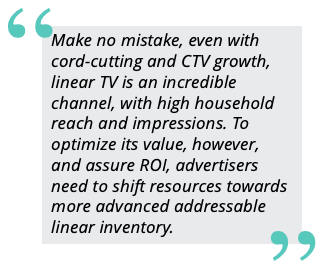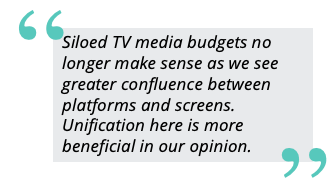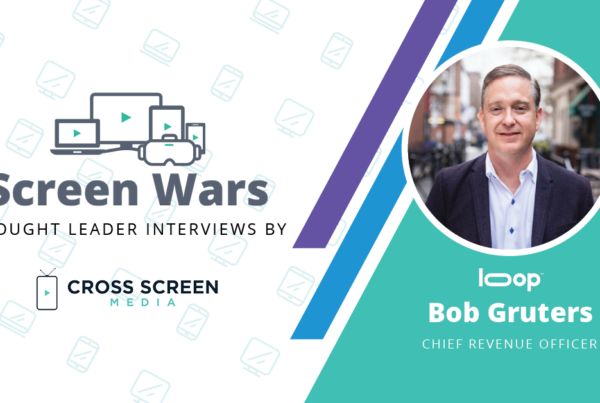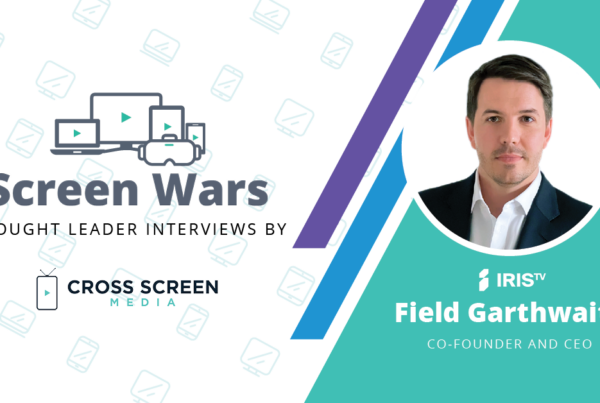Iván Markman, Chief Business Officer at Verizon, joins Cross Screen Media to share his unique insights on the latest developments, trends, and challenges across the Convergent TV Space in our latest Screen Wars Thought Leader Interview.
What was your first job and what lessons did you take from it that you have applied in your career?
My first job was my own business – I started a mobile DJ company in my teens and ran it through college. The two main learnings were customer empathy and the amazing self-reinforcing nature of customer delight.
What is the biggest change you have seen in the video ad marketplace since you started working at Verizon Media?
Until recently, advertisers have relied heavily on linear TV and social media to reach large, highly engaged audiences. Today’s world has impacted these go-to advertiser channels for myriad reasons: disruption to high valued broadcast programming, polarizing news cycles, and new focus on racial and social injustices that’s forced brands to rethink the impact of where they spend their media dollars. To navigate this new landscape, brands must look for new options that offer control, flexibility and scale – and connected TV (CTV) offers just that.
Streaming adoption is up 60% as the world stays home to fight COVID-19. But even before the crisis, the industry was seeing an explosion in CTV viewership. Last year, the audience exceeded 200 million for the first time. Fans are cutting the cord on expensive cable subscriptions, opting to watch their favorite shows on mobile devices or smart TVs, wherever and whenever they want.
For marketers, CTV is attractive, not just because it is where viewers are going, but because they can precisely target across digital channels alongside premium network-quality programming, and connect their planning, buying and measurement more tightly with other digital media.
How have you and the company adapted to this change?
We are enabling the category’s growth through our technology. The Verizon Media Platform helps over 10,000 of the world’s largest brands and publishers – including Disney, Fox and Discovery – prepare, deliver, display, and monetize streaming content on any device, anytime, anywhere. In total, we facilitate streams of over 2 billion videos every month and power over 10% of the world’s internet traffic.
As advertisers chase viewers, we’re also making premium streaming inventory easily available to buy programmatically through our omnichannel DSP. We are a true ecosystem player, supporting everyone – consumers, brands and publishers. 
Which development(s) are you most excited about within the Convergent TV space? Why?
We are seeing marketers flock to household addressable. As consumers increase TV time, advertisers are investing accordingly. But as spend rises, marketers want to ensure campaigns perform and that viewers get the most relevant, interesting ads. This is where household addressable advertising shines. It blurs the divide between linear and digital, using household-level audience data to deliver the best experiences. It combines digital’s targeting, personalization, attribution and performance with TV’s audience, sight, sound and motion, and premium inventory.
In connected TV (CTV), interactive ads bring the same type of engagement users expect on mobile or desktop devices to TV screens. CTV ads already drive 6x engagement vs standard pre-roll ads, and when you add in the fact that many consumers are using mobile devices while watching TV – with 71% looking up something related to the TV content (Nielsen/TechCrunch) – there’s incredible potential when you combine the two screens through interactive CTV ads.
I’m also excited by how easy it is to now plan, buy and manage TV inventory types — from CTV to household addressable — alongside one another, and then integrate these comprehensive TV campaigns with omni-channel media seamlessly .
Digital video ad spending is poised to surpass linear TV ad spending. Within linear TV, targeted ads (beyond age+gender) are rapidly gaining share. How should the different players in the industry capitalize on these shifts?
Advertisers and agencies should think about the convergence of these channels as more long-form video advertising becomes addressable. The unification of planning development, optimization and measurement capabilities will become increasingly critical to driving results.
For publishers, device manufacturers, and distribution partners, expanding addressable footprints, aligning with common industry standards and upgrading their ad platforms to support advanced TV monetization are the key factors to capitalize on these shifts.
With ongoing cord-cutting, what strategies should linear TV ad buyers and networks employ to drive business?
Make no mistake, even with cord-cutting and CTV growth, linear TV is an incredible channel, with high household reach and impressions. To optimize its value, however, and assure ROI, advertisers need to shift resources towards more advanced addressable linear inventory. Buying audiences, not just programming, is the future of the category. And then being able to connect the buy to omni-channel strategies seamlessly to maximize consumer engagement and ROAS.
On the network side, inventory owners need to highlight evolutions in technology that allow for sophisticated data-driven targeting and campaign measurability. Partnering with vendors that provide direct access to premium TV buyers and put linear inventory next to other in-demand channels — CTV, audio, DOOH, and beyond — is also key.
At Verizon Media, for example, we’re providing exciting and efficient ways for buyers to activate our premium content supply. Through our 30 owned-and-operated premium brands, we’ve opened publisher partnerships and packages to help brands navigate new opportunities in native, DOOH, video, CTV and more.
Many organizations have split their digital video and linear TV ad planning into two separate teams. In recent years, some organizations have moved to a more centralized model. Where do you think organizations should be headed in structuring their media planning/buying teams?
With the combination of a lack of “anchor programming,” the current economic outlook and an influx of new streaming outlets, there are fewer upfront commitments and a robust scatter market. In fact, $10 billion is predicted to shift from the standard upfront schedules in 2020 to the scatter market, where flexibility, ease of campaign planning and nimble optimization strategies are increasingly important. Buyers need more control and flexibility to navigate this new landscape. Siloed TV media budgets no longer make sense as we see greater confluence between platforms and screens.
Unification here is more beneficial in our opinion. As the channels blur and converge, with linear inventory available via addressable and programmatic, there will be a greater desire to bring digital and linear-buying together to boost alignment, data capabilities, flexibility and transparency. These channels are going to be bought and managed jointly and the buying teams will reflect that.
What does the future look like for cross-channel attribution, and how is Verizon Media approaching that challenge?
Cross-channel attribution is essential as buyers seek to connect the dots across screens and inventory types. It delivers a holistic top-down view of campaigns and helps marketers understand which touchpoints yield positive results. The core of omnichannel activation begins with powerful and accurate cross-screen data through our best in class identity graph.
Advertisers can buy premium mobile, video, desktop, native, CTV, addressable TV, audio, and DOOH inventory in one place, making it easier to assign credit to the appropriate medium while looking at how everything works together. We recently launched a TV tune-in attribution tool, for example, that identifies the effects of non-TV inventory on TV-viewing.
Verizon Media recently won Best of Tech Partner Awards as a DSP, SSP, and Ad Network. What initiatives have enabled your team to add value to such a broad set of customers/partners?
We are an advertiser and a publisher. Verizon is one of the biggest advertisers on the planet. Meanwhile, we are home to some of the world’s most recognizable media brands, including Yahoo, HuffPost and TechCrunch. Together with our exclusive partners, we reach nearly 900M users every month in trusted, meaningful experiences that generate rich first party data. As a result, we know both sides of the market extremely well, which gives us unmatched capabilities and expertise that we can bring to bear for our buyers, sellers and partners, with a deep consumer-centric view. We have also chosen to invest in an omnichannel platform, helping advertisers reach consumers on whichever screen or device they are on, and helping publishers maximize their inventory revenue and views.
See the rest of the Screen Wars Thought Leader Interview series here!
Iván Markman is the Chief Business Officer for Verizon Media, furthering the company’s business strategy and operations globally. Previously, he was Senior Advisor at Abundant Venture Partners and a Special Advisor to the CEO and Board of Directors of comScore, Inc. Iván’s career includes serving as General Manager of Marketing Services at Neustar, a real-time provider of cloud-based information services, following its acquisition of MarketShare where he served as Chief Operating Officer. Before joining MarketShare Iván was with Yahoo! as Global Head of Corporate Strategy. At Yahoo! he also served as Vice President of Operations Finance, where he drove key business planning, analytics, and financial initiatives for Yahoo!’s largest operating units. Iván is also an early-stage investor, board member and advisor across a series of emerging technology companies, leading and supporting various entrepreneurial ventures in technology, entertainment, new media, and education. For information on Verizon Media, please visit their website.
Cross Screen Media is a marketing analytics and software company empowering marketers to plan, activate, and measure Connected TV and audience-driven Linear TV advertising at the local level. Our closed-loop solutions help brands, agencies, and networks succeed in the Convergent TV space. For more information, visit CrossScreenMedia.com.





